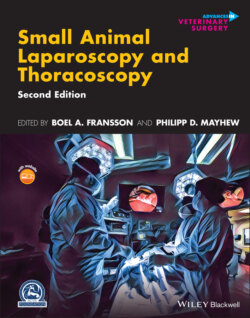Читать книгу Small Animal Laparoscopy and Thoracoscopy - Группа авторов - Страница 121
Wound Protector and Retractor Devices
ОглавлениеWound retraction devices (Figures 4.29 and 4.30) are used in minimally invasive procedures to improve surgical exposure with 360° wound edge retraction, protect wound edges from contamination, and facilitate laparoscopic‐assisted procedures [10]. Wound retractors improve surgical exposure by applying even, outward circumferential pressure to the wound margins, transitioning a linear incision to a circular opening with improved working space. This improved surgical exposure is achieved without the need for lengthening the incision and enables the surgeon to insert at least one finger into the abdomen, providing palpation and haptic feedback during exploration [11]. Benefits of using a wound retraction device include atraumatic circumferential wound retraction, barrier protection of the body wall and skin against contamination by bacteria and/or neoplastic cells, and improved extracorporeal intestine exposure without compromising vascular supply [11–13]. Reports in human medicine demonstrate a significant decrease in the occurrence of surgical site infection in patients undergoing major intestinal surgery when wound retractors are utilized [12, 13].
Wound retractors are available in a variety of sizes to match the surgeon's desired incision length and range from 2.5 to 25 cm. The smaller sizes (2.5 cm) are most frequently used in small animal MIS. The authors often use a SILS port through a 2.5 cm wound retractor for laparoscopic‐assisted abdominal exploratory and visceral biopsy. The use of wound retractors has been reported to facilitate a number laparoscopic and thoracoscopic procedures in veterinary medicine including abdominal explore and biopsy [14], gastrointestinal foreign body removal [10, 15], resection and anastomosis [16], splenectomy [17], cysterna cyhli ablation [18], pulmonary surgery [14, 19], and many hand‐assisted MIS procedures (Figures 4.29, 4.31–4.34).
Wound retractor placement is achieved by compressing the inner ring (internal ring) between the thumb and index finger creating an oval (Video 4.3). The compressed ring is inserted into the incision until the entire ring is positioned within the cavity and compression released. A finger is used to palpate the inner ring's position within the cavity to ensure that there is no entrapment of viscera between the inner ring and body. External traction is then applied to the outer ring (external ring) by the surgeon and assistant. The outer ring (external ring) is then rolled outward (similar to rolling down a tube sock), causing a shortening of the polyurethane sleeve relative to its original position. This rolling is easiest to perform with an assistant and is completed when the outer ring (external ring) is in contact with patient's body wall, entrapping the body wall snugly between the inner (internal) and outer (external) rings (see Figure 4.33).
Figure 4.28 (A). A suction irrigation device has many fenestrations in the tip for effective suctioning. (B). Commercial units are surprisingly cost effective and include a pump, tubing, and a handpiece for regulation of suction and irrigation actions. (C). Use of irrigation and suction.
Figure 4.29 Use of a wound retractor in abdominal minimally invasive surgery.
Figure 4.30 A wound retractor applies centrifugal force on the incision, greatly facilitating exteriorizing of intestines.
Figure 4.31 Wound retractor in the chest.
Figure 4.32 The wound retractor facilitates exteriorizing of organs while protecting the wound edges.
A wound retractor can also be used with a laparoscopic cap (Figure 4.34), which enables a laparoscopic approach before and after specimen retrieval.
